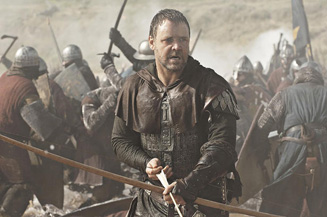Book Vs. Movie: Robin Hood
By Russ Bickerstaff
May 19, 2010
In this corner: the Book, a collection of words that represent ideas when filtered through the lexical systems in a human brain. From clay tablets to bound collections of wood pulp to units of stored data, the book has been around in one format or another for some 3,800 years.
And in this corner: the Movie, a 112-year-old kid born in France to a guy named Lumiere and raised primarily in Hollywood by his uncle Charlie "the Tramp" Chaplin. This young upstart has quickly made a huge impact on society, rapidly becoming the most financially lucrative form of storytelling in the modern world.
Both square off in the ring again as Box Office Prophets presents another round of Book vs. Movie.
Robin Hood
Robin Hood is a character of ancient British legend - a 600-year-old (or so) outlaw hero. Initially passed by word of mouth, the stories that make-up the legend of Robin Hood have been manipulated, mutated and evolved quite a bit over the years. Several hundred years after the first surviving Robin Hood ballads, an American writer and illustrator performed some rather major work on the legend in his novel The Merry Adventures of Robin Hood. Published in 1883, the novel advanced the 19th century trend of portraying Robin hood as less of an anti-hero and more of a straight-ahead hero - one who robbed only from the rich and gave the fruits of his labor to the poor and downtrodden. Over 120 years later, another group of Americans look to explore the legend in the format of yet another feature film under the direction of a prominent British director. How does the ancient novel’s revision of the legend stack-up against modern re-imagining of it?
The Book
Howard Pyle had been writing Robin Hood stories for various publications in the late 19th century. They had been successful enough for him to consider putting them together into a single, coherent work. Written in a fabricated old English that’s friendly to more contemporary American ears, Pyle’s 1883 Robin Hood stands up remarkably well over a century after it first appeared in print.
Pyle’s narrative style is grandiose to say the least. The novel opens with a sweeping introduction by the author. It’s an invitation to the reader to indulge in “moments of mirth and joyousness in the land of fancy.” From the first line, (and even the title) it’s apparent that Pyle isn’t interested in drawing out the darker ends of a story about a legendary outlaw.
Make no mistake about it, Pyle was trying to appeal to a young audience (children, in fact) with legends that had likely originated outside of children’s stories. The refreshing thing about this is the fact that it was written long before the days of overly simplified, overly sanitized Disney-style children’s fare. There’s an admirable complexity to the light tone of the novel that explores some of the difficulties with black and white morality. That it is able to do this without compromising brisk pacing, action or overall tension speaks to Pyle’s strengths as a storyteller.
Continued:
1
2
3
4




